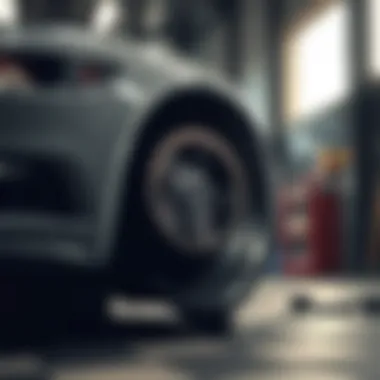Understanding the Cost of CV Boot Replacement


Intro
Maintaining a vehicle requires an understanding of its components—one often neglected yet crucial part is the CV boot. This rubber cover encases the constant velocity joint, protecting it from dirt, debris, and moisture. Over time, wear and tear can wear down the CV boot, leading to costly repairs down the line if not addressed promptly. Understanding the costs associated with replacing a CV boot can save you time, money, and headaches.
In this article, we will explore various factors affecting the cost of CV boot replacement, including the significance of its functionality and the impact of neglecting this component. Whether you're gearing up for a DIY endeavor or contemplating a trip to the mechanic, a solid grasp of what you're dealing with is crucial.
Performance Metrics
The consequences of a failing CV boot goes beyond just aesthetics; it affects fuel efficiency and handling.
Fuel Efficiency
A healthy CV boot helps maintain the integrity of the CV joint, ensuring smoother power transfer. When the boot is damaged, contaminants can enter, potentially leading to joint failure. A failing CV joint can lead to inefficient rotation, directly impacting fuel consumption. If your car is chugging more gas than usual, it might be worth looking under the hood—or rather, under the wheel well.
Handling and Stability
When the CV boot deteriorates, it can also compromise vehicle handling. Poorly functioning CV joints can cause vibrations during acceleration and sharp turns, which can be both annoying and dangerous. This instability might cause drivers to second-guess their maneuvers, leading to an uncomfortable driving experience. Fixing these issues can restore stability, providing drivers with confidence on the road.
"Ignoring a small issue can result in a major headache. Taking care of the CV boot is essential for overall vehicle performance."
DIY vs. Professional Options
Choosing between a DIY approach and professional help can significantly affect costs. Tackling the job at home might save dollars, but requires tools, space, and a fair amount of know-how. Alternatively, visiting your local mechanic could streamline the process but come with labor costs that can skyrocket, especially if additional parts need to be replaced.
Pros and cons exist for both.
- DIY Approach
- Professional Help
- Pros: Cost-effective, learning experience, control over the work done.
- Cons: Time-consuming, requires skills and tools, risk of improper installation.
- Pros: Quick service, professional-level assurance, warranty on labor and parts.
- Cons: Potentially high costs, less visibility into the work being done.
Long-Term Maintenance Considerations
Understanding the long-term implications of CV boot maintenance can help you avoid being caught off guard later. Regular checks can keep you ahead of potential problems and will save money in the long run. Some general maintenance tips include:
- Inspecting boots during routine service.
- Cleaning any debris that might accumulate around the boot.
- Being aware of any unusual noises or vibrations while driving.
By employing preventive strategies, you can lengthen the lifespan of your CV boot. A little diligence will ensure that you don’t find yourself facing unnecessary repair costs.
For more detailed information about vehicle maintenance, you might want to check out resources like Wikipedia or Britannica.
Understanding the cost of CV boot replacement isn't just about dollars and cents—it's about safeguarding your vehicle's performance and extending its life. Whether a seasoned mechanic or a budding DIY-er, making informed decisions is key.
Prelude to Boots
Understanding CV boots—those rubbery seals safeguarding your vehicle’s constant velocity joints—plays a crucial role in the everyday performance of your car. These components might not be the first thing that comes to mind when thinking about automotive upkeep, yet they are essential for ensuring smooth operation. They keep dirt, debris, and moisture at bay, preventing damage to vital internal parts like joints. When these boots start to crack or wear out, they can lead to significant problems down the line.
Definition and Function of Boots
CV boots are flexible protective covers that envelop the constant velocity joints. Constant velocity joints are mechanical components located at the ends of the drive shafts, allowing for power transfer from the engine to the wheels while accommodating various angles of motion and movement. Think of a CV boot as a raincoat for these joints. Just as a raincoat keeps you dry, a CV boot keeps grease within and external muck out, which is essential for the joints to function effectively. The material is typically rubber or a similar synthetic compound, allowing a fair degree of flexibility and durability under different driving conditions.


Importance in Vehicle Performance
The role of CV boots in vehicle performance cannot be overstated. When functioning correctly, they allow for safe and efficient motion between the axle and wheels without any squeaks or pops. Failure of a CV boot can lead to a myriad of issues that affect not only the specific joint but also the vehicle's overall handling and safety.
Ignoring that little crack could lead to a lot more than just a minor inconvenience. If the boot fails, dirt and moisture can ruin the CV joints requiring a much more extensive and costly repair.
One fascinating aspect is how these seemingly small components significantly impact fuel efficiency. A compromised CV joint can lead to decreased performance, causing the engine to work harder and burn more fuel. Furthermore, a well-maintained CV boot helps prolong the life of your CV joints—often making the difference between a minor repair and a complete joint replacement, which can be costly.
As we delve deeper into this article, we aim to unravel the cost surrounding CV boot replacement and why it's paramount to keep an eye on these unnoticed components. This understanding not only enhances your knowledge of vehicle maintenance but also aids in making informed choices when faced with replacement decisions.
Signs of a Failing Boot
Understanding the signs of a failing CV boot is crucial. Early detection can save you from costly repairs down the line and keep your vehicle running smoothly. The CV boot plays a pivotal role in protecting the constant velocity joint from dirt, debris, and moisture. If it starts to show signs of damage, it can lead to joint failure, compromising not just performance but safety as well.
Visual Indicators of Damage
One of the first things to look out for are visual indicators of damage. The CV boot is generally made of rubber. Over time, exposure to harsh elements and road conditions can lead to cracks, tears, or even complete ruptures. Here are some unique signs to inspect:
- Cracking: Check for fissures on the outer layer. If they’re more than just surface cracks, it could spell trouble.
- Rips or holes: Inspect for any noticeable tears in the boot. A torn boot allows dirt and grime to enter the joint, increasing the risk of failure.
- Grease leakage: If you see grease splattered around the wheel area, it’s a sure sign that the boot is compromised.
While inspecting, don’t only rely on what you see from a distance. A close-up examination can often reveal hidden issues that might otherwise go unnoticed.
Sounds Indicating Potential Issues
The sounds indicating potential issues also serve as reliable indicators of CV boot problems. A failing boot may lead to sounds that, when unexplained, could rattle even the most seasoned drivers. Listen carefully for:
- Clicking noises: If you hear a clicking or popping sound during sharp turns, it’s often a symptom of a damaged CV joint which could be linked to a compromised boot.
- Grinding sounds: This noise can indicate that debris has entered the joint, causing wear and tear. It’s not something you want to ignore.
- Whining or howling: Some might refelct a worn axle that correlates with boot deterioration.
If these sounds start to surface, it’s wise to take action swiftly. Ignoring what you hear could lead to more significant, costly repairs.
Impact on Vehicle Handling
The impact on vehicle handling is another critical aspect to consider. A compromised CV boot can lead to increased wear on the CV joint itself, which in turn disrupts the handling characteristics of your vehicle. Here’s how it affects performance:
- Reduced steering response: You might notice your vehicle does not handle the road as well, especially during turns.
- Vibrations: Excessive vibration during driving can occur if the joint is not functioning correctly, which often results from a failing CV boot. This not only is uncomfortable but also can lead to erratic handling.
- Alignment issues: A damaged boot can lead to uneven component wear, contributing to misalignment. This may cause the vehicle to pull to one side, which can be dangerous.
In summary, keen observation of visual cues, sound anomalies, and vehicle handling characteristics will empower you to catch CV boot issues early. This proactive approach can ultimately save money while maintaining the integrity of your vehicle.
Cost Factors in Boot Replacement
When it comes to the replacement of CV boots, understanding the cost factors is crucial. CV boots are essential for shielding the constant velocity joints from dirt and debris, which can ultimately lead to significant mechanical issues if left unchecked. The costs associated with replacing them encompass various aspects, such as labor, parts, and regional pricing fluctuations. Recognizing these factors not only aids vehicle owners in budgeting for necessary repairs but also empowers them to make informed decisions about vehicle maintenance.
Labor Costs Overview
Labor costs can be a significant portion of the overall expense of replacing CV boots. Technicians usually charge by the hour, and rates can vary widely depending on factors like location and shop reputation. An experienced mechanic may charge anywhere from $75 to $150 per hour. The job itself typically takes about one to two hours, depending on the vehicle and the labor involved.
Having a clear grasp of labor costs is essential, especially if you’re considering professional help. It's prudent to get multiple estimates from different auto shops. This way, you can avoid falling into the trap of overpaying while ensuring you get quality service.
Parts and Material Expenses
The cost of parts and materials plays a crucial role in the total expense of CV boot replacement. This encompasses several components which are pivotal to a successful repair.
Boots


CV boots serve as the frontline defense for your vehicle's constant velocity joints. Quality boots can cost anywhere from $10 to $50 each. Material play a role - rubber versus thermoplastic polyurethane, for example. Rubber boots are common due to affordability but can have a shorter lifespan, especially in extreme conditions. Polyurethane boots, while slightly more expensive, are more durable and resistant to cracking.
These boots come in various shapes and sizes, so it’s essential to ensure you are buying the correct fit for your specific vehicle model. The wrong boot can lead to additional repairs, ultimately increasing overall costs.
Grease and Seals
Next up, grease and seals are vital to ensure a smooth operation of the CV boot. While the cost for grease is relatively minimal - usually around $5 to $15 - it's essential not to skimp on quality. The right type of grease can help maintain lubrication in crucial areas and prevent premature wear.
Seals are equally important because they protect against dirt and moisture intrusion. Neglecting to replace worn-out seals can lead to more severe damage down the line, turning a straightforward repair into a costly mishap.
Other Necessary Components
Additional components also add to the overall expense. Often, clips or clamps are needed to secure the CV boots in place when reassembly occurs. These typically cost anywhere from $2 to $10 each, depending on the material and size required. If repairs involve significant wear to the constant velocity joints themselves, those parts will dramatically increase the repair costs, possibly reaching hundreds of dollars.
Regional Variations in Pricing
Finally, it’s important to recognize that the cost of replacement can vary based on geographical location. In urban areas, where labor rates tend to soar higher, prices can reflect this. Conversely, rural locations may offer lower rates, but the availability of qualified mechanics can also impact the costs due to limited options. Factors such as local competition and demand for automotive services in your area can create price disparities.
"Understanding these cost factors can save you not only money but also prevent future vehicle issues that come from delayed repairs."
In summary, knowing the nuances of labor charges, parts prices, and regional factors will contribute to a smoother CV boot replacement experience, illuminating the pathway to a well-maintained vehicle.
Do-It-Yourself vs Professional Replacement
When considering the replacement of a CV boot, you’re often faced with a pivotal choice: should you take the reins and tackle this project yourself, or is it wiser to hand it over to a seasoned professional? Understanding this decision carries weight not only in terms of financial implications but also in ensuring your vehicle’s health and performance.
Benefits of DIY Replacement
Opting for a do-it-yourself (DIY) replacement of a CV boot can yield several advantages that may entice you to roll up your sleeves and get to work. First off, save a few bucks. Labor costs at automotive shops can stack up quickly, while handling the job yourself can keep dollars in your pocket. Plus, it can offer a profound sense of satisfaction once you see the fruits of your labor.
Another perk is the opportunity to enhance your mechanical skills. If you’re the kind of person who enjoys getting hands-on, this can be an educational adventure. Learning the ins and outs of your vehicle fosters a deeper connection, making you more invested in its upkeep.
Additionally, completing the work at your own pace can be a significant benefit. You can fit the task into your schedule instead of rushing to meet a garage's working hours. No one enjoys the waiting game at a mechanic’s.
Challenges of DIY Approach
Not everything is sunshine and rainbows in the world of DIY. One major hurdle is the necessity for the right tools. If you’re not well-equipped, the initial investment in wrenches and grease can make the financial benefits seem moot.
Furthermore, diagnosing issues accurately can be tricky if you don’t have a trained eye. What if the issue stems beyond just the visible damage of the boot? There might be hidden problems that could wreak havoc on your vehicle if not addressed. And let’s not forget about the time commitment; if the job takes longer than anticipated, you could find yourself in a bind, especially if you rely on your vehicle for daily commutes.
When to Seek Professional Help
Despite the allure of DIY, certain scenarios warrant bringing in the pros. If you’re not confident in your mechanical bearings or the task calls for specialized knowledge, a professional can often be your best bet. Complexities such as dealing with foreign car models or advanced driveline systems are common cases where their expertise shines.
Moreover, if you notice multiple issues or suspect that the CV boot failure could have led to additional damage, a professional assessment can guide you in the right direction. Investing in a thorough inspection might save you from bigger headaches down the road.
"Being informed might just be the best tool in your toolbox."
For those looking to dive deeper into DIY auto repairs, resources like Reddit and Wikipedia can provide additional insights and community support.
Consequences of Ignoring Boot Issues


Ignoring issues with CV boots can lead to a cascade of problems that extend far beyond the boot itself. Many car owners may brush off minor cracks or bumps, thinking it's just a cosmetic problem. However, failing to address CV boot issues can severely impact the vehicle's performance and longevity.
Potential Damage to Other Components
When a CV boot starts failing, it often introduces dirt and moisture into the CV joint. This component is critical, as it allows the drive shaft to transfer power effectively while accommodating the movement of the suspension. A compromised CV joint can wear down much faster. Therefore, what may seem like a small issue can escalate into significant component failure,
Potential damage includes:
- Joint Wear: As contaminants enter the joint space, they cause accelerated wear, resulting in a joint that may require replacement.
- Front Suspension Issues: A faulty CV joint can also impact vehicle handling, creating a rougher ride and uneven tire wear. This not only reduces driver comfort but can also make driving unsafe.
- Increased Stress on the Transmission: When the CV joint fails, it may lead to excess stress on the transmission, possibly causing further expensive repairs.
"Neglecting small problems can lead to big headaches; it's like ignoring a toothache until it needs a root canal."
Long-Term Repair Costs
Neglecting the CV boot can lead to spiraling repair costs. After all, a simple replacement of a boot is often far cheaper than fixing the issues that arise due to the damage sustained by the CV joint and surrounding components.
When significant components fail, the cost can vary between:
- CV Joint Replacement: This procedure often ranges from $200 to over $800, depending on the vehicle and labor costs.
- Suspension Repairs: These costs can run into the thousands if multiple components are affected, not to mention that poor suspension can lead to safety hazards.
- Transmission Work: Additionally, if the transmission sustains damage, repairs can reach upwards of $1,000 or more.
In contrast, replacing a CV boot proactively can range from $150 to $300. The difference in expenses clearly illustrates the importance of timely maintenance. Staying alert to CV boot conditions can mitigate risks and allow for more economical repairs down the line.
Maintenance Tips for Boots
Understanding the maintenance tips for CV boots is crucial for car owners and enthusiasts who want to prolong the life of their vehicles. By taking care of these components, drivers can avoid costly repairs and enhance vehicle reliability. Here’s how to keep those CV boots in prime condition:
Regular Inspections
Conducting regular inspections is one of the most effective ways to maintain CV boots. Drivers should check for any signs of wear, cracks, or tears at least once every few months. During routine services or oil changes, make it a habit to inspect the CV boots for:
- Grease leakage: This is often the first visible sign that a boot is damaged. If grease oozes out, it’s a red flag.
- Cracking or splitting: These can lead to contamination from dirt and moisture, drastically reducing the lifespan.
- Debris accumulation: Stones and other debris can cause wear on the boots. Keeping the area clear is essential.
By spotting these issues early, drivers can often fix the problem before it escalates, saving both time and money. Remember, a little vigilance goes a long way in vehicle maintenance.
"An ounce of prevention is worth a pound of cure."
Driving Habits to Consider
Besides regular checks, your driving style significantly impacts the health of your CV boots. Here are some habits to consider:
- Avoiding Sharp Turns: Frequent sharp turns can put extra stress on the CV joints and boots, wearing them out faster.
- Rough Roads: If rough terrain is unavoidable, driving more cautiously can help protect the boots from damage.
- Slow Accelerating and Braking: Sudden movements can create stresses on the CV boots that can lead to premature failure.
It’s also advisable to be cautious with heavy loads. Excess weight can strain the CV joints and adversely impact the boots. Adapting your driving habits isn’t just about comfort; it’s about ensuring the longevity of your vehicle’s components, thus minimizing future repair costs.
By integrating these maintenance tips into your routine, you can significantly enhance the lifespan of your CV boots and improve the overall performance of your vehicle.
The End
Recap of Replacement Importance
To recap, the CV boot might appear small amidst the complex mechanics of a vehicle, yet it safeguards critical components like the CV joint from dirt and debris. Ignoring its upkeep or the need for replacement can lead to significant damage, greatly escalating repair costs down the line. Keeping an eye on the condition of your CV boots can prevent much graver issues that can affect performance and safety. It’s a small investment in maintenance, but the return is invaluable—saving you both headaches and money.
Final Thoughts on Vehicle Care
When attending to your vehicle, having a proactive approach to maintenance—like replacing worn CV boots—will pay dividends. Regular checks not only prolong the life of your vehicle but they also enhance performance and reliability. As the saying goes, an ounce of prevention is worth a pound of cure; it's apt here. Keep your vehicle’s health in check, and you’ll drive smoother down the road.
"Investing in small repairs today can prevent larger, more costly problems tomorrow."
For those who may not be mechanically inclined, don’t hesitate to seek help from professionals, as they can provide the expertise needed to ensure everything is up to par. In closing, whether you opt for DIY repairs or professional assistance, understanding the fine print of CV boot replacement fosters better vehicle stewardship.



